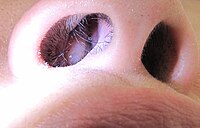
Photo from wikipedia
I have read with great interest the review article by Yao et al. [1] on the existing and emerging biomarkers available for the evaluation and management of chronic rhino-sinusitis with… Click to show full abstract
I have read with great interest the review article by Yao et al. [1] on the existing and emerging biomarkers available for the evaluation and management of chronic rhino-sinusitis with nasal polyposis (CRSwNP). Among other biomarkers, the Authors mention nasal nitric oxide (nNO) as a non-invasive tool for assessment of sinus ostial patency. In fact, several studies report a nNO reduction in patients with nasal polyposis, principally due to sinus ostial occlusion and failure of gaseous NO in the sinuses to reach the nasal cavities [2, 3]. In their review, Yao et al. focus only on studies that evaluated nNO during quiet exhalation or aspiration. The use of nNO in diagnosis or treatment evaluation of sino-nasal diseases has been questioned as some studies made no distinction between chronic rhinosinusitis with or without polyps, and had conflicting results on the possibility that nNO is significantly lower compared to controls [4]. A possible explanation is that nNO measurement in sino-nasal pathologies is currently hampered by confounding factors such as the continuous gas exchange between the nasal airway and paranasal sinuses, which may affect the ability to detect alterations in nasal NO occurring in sino-nasal disorders [5]. Surprisingly, Yao et al. [1] did not mention the measurement of nNO during humming (which is the production of a tone without opening the lips or forming words), which has been shown to correlate with ostial function [6, 7], with a potential use as test for osteo-meatal patency. In normal conditions humming causes a great increase in nasal NO (humming responders), due to the fast gas exchange between sinuses and nose induced by the sounding airflow. In presence of an obstruction of osteo-meatal complex (OMC), this manoeuver does not cause any increase in NO (humming non-responders). This method represents a suitable non-invasive test to assess sinus ostium block, and is useful for sinus disorder screening, for post-medical and post-surgery follow-up in patients with bilateral nasal polyposis [8]. In fact, a complete absence of the normal nNO increase during humming was found in patients with bilateral nasal polyposis and CT-proven occluded sinus ostia, and nNO levels were restored after surgery [8]. In addition, in patients with allergic rhinitis, 80% of humming non-responders presented endoscopic signs of bilateral sinus obstruction, compared with less than 5% of humming responders [9]. An association between radiographic OMC patency and nNO during humming and quiet measurements was also found by Shusterman et al. [10]. Therefore, it is likely that humming test may also characterize an on–off response in the presence of advanced ostium disease. In conclusion, I think that the nNO certainly represents a useful biomarker for the evaluation and management of CRSwNP, especially if assessed during humming maneuver, avoiding the confounding factors that may affect the ability to detect alterations in nNO occurring in sino-nasal disorders [5].
Journal Title: European Archives of Oto-Rhino-Laryngology
Year Published: 2017
Link to full text (if available)
Share on Social Media: Sign Up to like & get
recommendations!